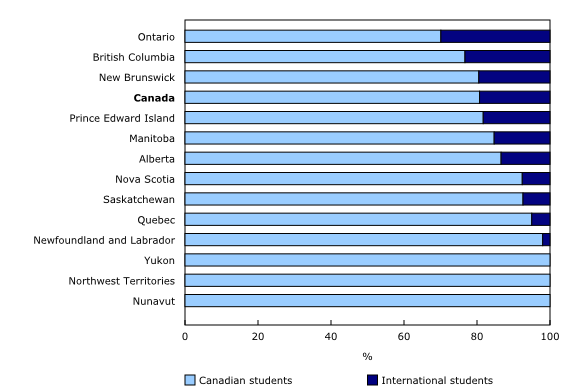International Students are a Key Part of Canada's Future

International students in Canada are, in so many important ways, an integral part of Canada's present - and future.
And as visitors, they look to us, Canadians, for help, guidance, understanding and experience. Do we fail them? Sometimes. But they remain a force in this country, an unstoppable energy source shaping our common destiny.
There are many reasons why they come to us: superior education opportunities, diversity, safety and affordability.
They have other choices - the United States, Australia, the United Kingdom, and even China. But they choose us in huge numbers.
Thousands of international students choose Canada
Every year, thousands and thousands choose to study in Canada. And to do so, they pay sky-high tuition, they work hard at part-time jobs, and, yes, sometimes, they are taken advantage of. Too often, actually. But they come, and many, many of them choose to start a new life here.
Recent information released by Immigration, Refugees and Citizenship Canada (IRCC) revealed that in 2022 Canada received a record 551,405 international students from 184 countries.
Bob Dhillon working to raise awareness
And, setting another record, as of Dec. 31 of last year, 807,750 international students now hold valid study permits.
As Bob Dhillon, the CEO of Mainstreet Equity Corp., told Rentals for Newcomers, "I’ve really tried to raise awareness about the massive economic contribution made by immigrants and international students. For example, according to the Government of Canada, international students contributed $16.2 billion and $19.7 billion to our GDP in 2017 and 2018."
And as Krista Ross, president of the Fredericton, New Brunswick Chamber of Commerce, wrote recently: "We also need the private sector to double down our efforts to work with post-secondary institutions and government to create meaningful opportunities for (international) students to gain experience, make connections and start to make a life in the province. Of course, for both the student and business, the goal is to turn these opportunities into permanent positions."
I’ve really tried to raise awareness about the massive economic contribution made by immigrants and international students - Bob Dhillon
In 2014 the federal government set a target of increasing the yearly number of international students to over 450,000 by 2022.
In 2021, there were 845,930 valid study permit holders in Canada. That number climbed to 917,445 by Sept. 30 of 2022.
According to a Dec. 2022 Toronto Star story by Nicholas Keung and Ana Pereira, international students, through their spending and tuition, contribute $22 billion to the Canadian economy and support 170,000 jobs in the country.
Students are well-positioned for permanent residency
Earlier this year, Immigration Minister Sean Fraser addressed a conference regarding the good position Canada was in compared to the rest of the world regarding what it can offer international students.
“International students bring extraordinary employment skills, and with many of them having work experience in Canada, they’re well positioned to apply for permanent residency on the back end of their studies,” said Fraser.
“These students are helping to fill a pressing need in areas like healthcare and tech, and as more students build their future in Canada, this is going to contribute directly to our economic recovery and our long-term prosperity," he told the conference.
SUKHMANI HAVEN LAUNCHES IN ONTARIO TO SUPPORT PUNJABI INTERNATIONAL STUDENTS https://t.co/FYwQ2zoPZC
— sarbjit kaur (@sarbjitkaur1) July 13, 2022
“We don’t just want you to study here – we’re hoping to create pathways that allow you to stay her and make a lasting contribution beyond your academic career."
The federal government, in an effort to bolster the pool of foreign labour, said it was temporarily lifting the 20-hour weekly limit on the number of hours that international students could work off-campus while postsecondary classes are in session.
This decision is expected to make Canada even more attractive to international students going forward.
While employers and many international students lauded this move, Mario Bellissimo, founder of Toronto-based Bellissimo Law Group, warned that foreign students are ripe for exploitation and that the expansion devalues their reason for being in Canada: to study.
“We’re already seeing individuals calling us, worried that if they don’t work the extra hours, they’re going to lose their jobs,” he told The Globe and Mail.
Here are some facts and insights for those thinking of studying abroad in Canada about the journey and the impact they will have on this country:
- India, the world’s second-largest English-speaking population, is the leading source country. It accounts for almost 35 percent of Canada’s international student cohort. China is second, and France is third.
- Students from abroad are the largest source of temporary migrant workers in Canada
- During the past three difficult years, over 350,000 international students received a postgraduate work permit. In 2019, nearly 60,000 became permanent residents.
PEAC is a free and flexible employment program for recent #Grads.
— JVS Toronto (@JVSToronto) April 19, 2022
- Career exploration workshop
- Networking strategy
- Job Search support
- Connections to employers
Starting in May. Contact Boyoung.lee@jvstoronto.org for more info. #torontojobs #gtajobs #gradjobs #jobsforgrads pic.twitter.com/hgJiSjziFf
- For international students, the initial step toward studying in Canada is to research educational programs and designated learning institutions (DLIs). DLIs are universities, colleges, and other post-secondary institutions approved by the government to host international students.
- The next step is to submit applications to DLIs and if approved, obtain a Letter of Acceptance (LOA).
- Once the LOA has been obtained, international students can then submit a study permit application to Immigrant Refugee and Citizenship Canada (IRCC).
- The IRCC will then weigh factors such as proof students have a true interest in studying in Canada plus the financial means to support their study and living expenses.
- The IRCC also offers the Student Direct Stream (SDS), an expedited study permit pathway to residents of 14 countries, the largest of which are India, China, the Philippines, Pakistan, Vietnam, Morocco, Senegal, Brazil, Columbia, and Peru.
- Immigration, Refugees and Citizenship Canada (IRCC) releases data every month of new study permits that take effect. These are new students arriving in Canada and foreign nationals already living in Canada who successfully obtain a study permit.
- In 2021, 450,000 new study permits took effect in Canada, breaking the previous all-time record set in 2019.
If you missed our amazing webinar for #internationalstudents about renting a place to live in Canada you can watch it here. #studyincanada #renting #studyabroad #livingincanada #rentingtostudents #rent #webinar #IndiaCanada #ChinaCanada #newcomerstocanada https://t.co/WhUyTx9bou
— rentalsfornewcomers (@rentalsfornewc) April 18, 2022
- Just over 400,000 new study permits were issued prior to the pandemic. That figure dropped to just over 255,000 in 2020. Last year’s total represents a doubling compared to 2015.
- In the period between July 2021 and August 2021, over 200,000 new study permits were issued, the most ever, before the start of the 2021/22 school year.
- International students pay three to four times more in tuition fees than Canadian-born peers.
- International students now contribute an estimated $21 billion annually to the Canadian economy.
- Canada hosted, as of December 31, 2021, almost 622,000 international students.
- In 2019, this country's international student population was 640,000. That fell to 530,000 in 2020.
- Universities and colleges in Canada are solidly dependent on international student fees as a major source of tuition revenue.
- Just before the beginning of the pandemic, a Statscan study revealed that in 2017-18, almost 24 percent of new enrolments in universities were by international students. In colleges, it was just over 16 percent.
- The number of international students in universities has nearly doubled in eight years, and in colleges, it's almost tripled. Revenue from international student fees in universities and degree-granting colleges was $12.7 billion in 2019-20.
- According to Global Affairs Canada, international students spent $22.3 billion in 2018 on tuition, accommodation and discretionary expenditures.
“I just wanted people who are thinking of coming here to visit or study to see what winter in Charlottetown really looks like,” said Patel during an interview with the Saltwire Network.https://t.co/sWBFNsFhJY #AtlanticCanada #PEI #SOPAAT #NewcomersPerpective
— SOPA (@ArrivePrepared) April 18, 2022
- China is still the prime source of international students in universities. India is No. 1 for college enrollees.
- Ontario is home to approximately 280,000 international students
- Despite challenges and hardships, many international graduates become permanent residents. In 2021, over 88,000 moved directly from a postgraduate work permit to permanent residence. In 2019 that number was 28,000.
- International students in Canada have full protection under the Canadian Charter of Rights and Freedoms.
- 60.6 percent of international students were enrolled in universities in the 2019-2020 school year, and the proportion studying in colleges, at 39.4 percent, is steadily increasing.
- Since the 2015-16 school year, the number of international college students has more than doubled (from 60,318 to 153,360 in 2019-2020).
- In the same period, the number of international university students rose from 168,606 to 235,422.
Here are the Top 10 international student source countries for Canadian schools (by the number of study permit holders on December 31, 2022):
- India (226,450 students)
- China (52,165 students)
- Philippines (23,380 students)
- France (16,725 students)
- Nigeria (16,195 students)
- Iran (13,525 students)
- Republic of Korea (11,535 students)
- Japan (10,955 students)
- Mexico (10,405 students)
- Brazil (10,405 students)
Here are the Top 10 source countries of international students already living and studying in Canada on Dec. 31, 2022:
- India (319,130 students)
- People’s Republic of China (100,075 students)
- Philippines (32,455 students)
- France (27,135 students)
- Nigeria (21,660 students)
- Iran (21,115 students)
- Republic of Korea (16,505 students)
- Vietnam (16,140 students)
- Mexico (14,930 students)
- United States (14,485 students)
And here's where international students attended Designated Learning Institutions within Canada in 2022 in the following provinces:
- Ontario (411,000 students)
- British Columbia (164,000 students)
- Quebec (93,000 students)
- Alberta (43,000 students)
- Manitoba (22,000 students)
- Nova Scotia (20,850 students)
- Saskatchewan (13,135 students)
- New Brunswick (11,140 students)
- Newfoundland and Labrador (6,175 students)
- Prince Edward Island (4,485 students)
The proportion of international students studying in colleges and universities varied across provinces and territories.
For example, almost a third of college students in Ontario (29.9 percent), and more than one in five in British Columbia (23.3 percent), were from outside Canada.
By contrast, colleges in Saskatchewan (7.4 percent), Quebec (including CÉGEP—5.0 percent) and Newfoundland and Labrador (2.0 percent) had far fewer international student enrolments. In general, international student enrolments accounted for 19.3 percent of all students enrolled in colleges in Canada.
College enrollments by the status of the student in Canada and the province of study, 2019/2020

University enrollments by the status of the student in Canada and the province of study, 2019/2020

At the national level, international students represented 17 percent of total university enrolments. This proportion varied from the highest in Prince Edward Island (27.8 percent), Nova Scotia (26.3 percent) and British Columbia (24.1 percent) to the lowest in Alberta (11.5 percent).
Another significant factor in the recovery was Canada’s easing of Post-Graduation Work Permit (PGWP) rules. Before the pandemic, IRCC did not allow distance learning to count towards PGWP eligibility, but they have temporarily relaxed this policy until August 31, 2022, to help those who want to go ahead with their Canadian study plans amid the pandemic.
How international students can obtain a PGWP
International students that complete their studies at an eligible Canadian designated learning institution (DLI) may be able to obtain a PGWP.
The PGWP is coveted since it enables international graduates to gain the Canadian work experience they often need to be eligible to apply for permanent residence.
Sources: Statistics Canada, Toronto Star, Reuters, CIC News, Prepare for Canada, Aha Insurance, Scotiabank
Helpful Resources for International Students:
- Amazing webinar for international students about renting a place to live in Canada
- Planning for housing, such as short-term rentals, before you arrive
- Guide to renting in Canada
- 5 reasons why international students renting in Canada need tenant insurance
- How students can avoid rental scams
- Choosing a Canadian city for school, work and renting
- How to register to find an apartment through Rentals for Newcomers
- Helping students learn about banking in Canada
- Why do international students need a rental strategy?
- 10 tips for saving money on rent in Canada
- 10 tips for newcomer tenants AND landlords
- Knowing the difference between a condo and an apartment
- When and why would international students need a travel insurance policy?
- More banking tips for international students in Canada
- International students: learn about banking before you arrive
- How to open an international bank account before you arrive
When it comes to securing your housing in Canada, Rob Watt, the CEO of The DMS Group offers this advice: "The market fills up in the spring and in the summer. So most of the product that is desirable, that is close to campus and has the amenities and the services that you'd want will be rented up prior to the beginning of the fall semester."

That advice is echoed by Adi Brar of Mainstreet Equity Corp. and a former international student: "Apply (to rent) early. Do not leave this decision to the end. This is a very competitive (housing) market. Most units get rented before the summer's over."
You can also watch another webinar here featuring expert rental advice for International Students featuring Jesse Greenwell and Yash Gupta of Mainstreet.
And check out this great visual storytelling graphic on international students in Canada from the Canadian Bureau for International Education.
The Toronto Star's Hard Lessons Series:
As mentioned above, the reality of the international experience sometimes is more challenging than imagined. As Toronto Star journalist Nicholas Keung has pointed out, some students studying abroad in Canada face obstacles such as unforgiving timelines, social isolation, and exploitation by employers and others.
In an excellent recent series called Hard Lessons, The Toronto Star takes an in-depth look at how Canada is succeeding and failing in its commitments to some international students:
#HardLessons: A heart-felt first-person story from a caring college professor about the struggles and realities her #InternationalStudents face in and outside of the classroom. "Within the classroom you can see the layers of vulnerability." #Canada https://t.co/xTUKREozUd
— Nicholas Keung 姜巧樂 (@nkeung) April 6, 2022
If you have a question, please email us at rentals@prepareforcanada.com
Steve Tustin is the Editor for Rentals for Newcomers and a contributing editor for Prepare for Canada. He is also the former managing editor of Storeys.com and a former senior editor at the Globe and Mail and the Toronto Star.
*Rentals for Newcomers used no AI-generated content in the writing of this story, and all sources are cited and credited where possible.
© Rentals for Newcomers 2024


